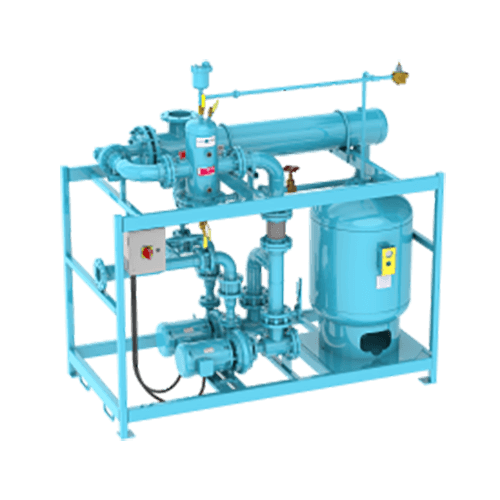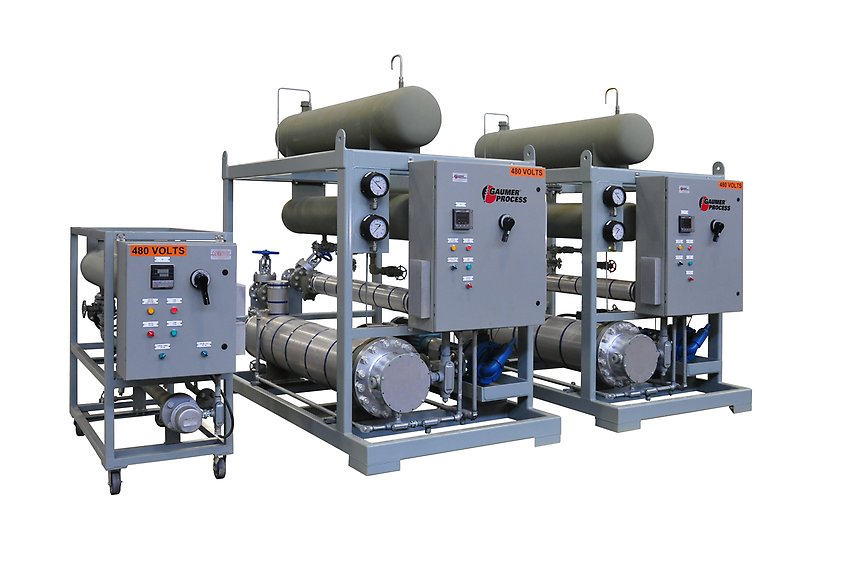Innovations in Heat Transfer Systems: What You Required to Know for Ideal Efficiency
Technologies in Heat transfer systems are transforming performance throughout different markets. Advanced products like graphene and nanofluids promise significant improvements in thermal conductivity. On the other hand, the integration of IoT and machine understanding offers possibilities for real-time surveillance and improved energy performance. Nevertheless, the landscape of thermal administration is quickly advancing (DVS Heat Transfer Systems). Comprehending these growths is vital for attaining suitable system performance and sustainability in the future. What details developments are forming this transformation?
Emerging Products for Enhanced Heat Transfer

Advanced Heat Exchanger Layouts
While typical Heat exchangers have actually offered their function in various applications, advanced styles are now arising to fulfill the raising needs for efficiency and performance. These ingenious layouts, such as plate, shell-and-tube, and finned-tube Heat exchangers, include improved surface areas and enhanced flow patterns to enhance thermal transfer rates. Additionally, compact layouts enable minimized space demands without endangering performance. Advanced products, such as composites and corrosion-resistant alloys, additionally boost sturdiness and efficiency under extreme conditions. Simulation innovations and computational liquid dynamics are increasingly used to fine-tune these styles, making sure peak Heat transfer characteristics. As industries look for to lessen power consumption and optimize outcome, the fostering of innovative Heat exchanger styles is essential in accomplishing these purposes.
The Duty of Nanotechnology in Heat Transfer
Nanotechnology plays a crucial role in boosting thermal conductivity within Heat transfer systems. By adjusting products at the nanoscale, scientists have actually achieved significant improvements in power performance. These developments not only optimize performance yet likewise add to more sustainable power options.
Boosted Thermal Conductivity
Substantial innovations in thermal conductivity have actually arised via the application of nanotechnology, changing Heat transfer systems throughout various sectors. By including nanoparticles right into Heat transfer fluids and materials, scientists have accomplished exceptional boosts in thermal conductivity. These nanoparticles, such as carbon nanotubes, graphene, and steel oxides, enhance the Heat transfer residential properties because of their high surface location and special thermal characteristics. The resulting composites exhibit improved performance in applications ranging from electronics cooling systems to eco-friendly power technologies. The capability to tailor the size, shape, and composition of nanoparticles permits for maximized thermal management solutions. Because of this, nanotechnology remains to play an essential duty in the advancement of more reliable and effective Heat transfer systems, leading the way for boosted commercial applications.
Power Performance Improvements

Assimilation of IoT in Heat Transfer Solutions
The integration of IoT in Heat transfer systems presents the implementation of clever sensing units that boost operational performance. These sensors make it possible for real-time information surveillance, permitting prompt adjustments and optimizations. This technical innovation has the potential to significantly boost efficiency and energy management in Heat transfer applications.
Smart Sensors Implementation
As Heat transfer systems advance, the integration of wise sensing units via the Net of Things (IoT) has emerged as a transformative strategy. These sensors allow real-time monitoring of temperature level, pressure, and flow prices, enhancing system effectiveness and integrity. By accumulating and sending information, they assist in aggressive maintenance, minimizing the danger of system failures. In addition, smart sensors add to power cost savings by refining functional criteria based on environmental conditions. Their ability to analyze trends and anomalies permits educated decision-making, making certain peak performance of Heat transfer systems. As industries increasingly embrace this innovation, the application of smart sensing units stands to revolutionize exactly how Heat transfer systems are taken care of, leading the way for better sustainability and improved efficiency outcomes.
Real-Time Data Tracking
Just how can real-time data keeping track of boost the performance of Heat transfer systems? By incorporating Net of Things (IoT) modern technology, Heat transfer systems can utilize constant information collection from wise sensing units. This real-time monitoring enables immediate evaluation of circulation, stress, and temperature rates, making it possible for operators to recognize ineffectiveness quickly. Adjustments can be made to optimize performance, decrease power consumption, and expand devices lifespan. In addition, predictive upkeep can be implemented, minimizing unforeseen downtime and costly repair work. The ability to imagine efficiency metrics through control panels boosts decision-making, fostering a positive strategy to system monitoring. Ultimately, real-time data keeping an eye on not only boosts functional efficiency but likewise contributes to sustainability objectives within commercial procedures.
Power Effectiveness and Sustainability Trends
Energy performance and sustainability trends are reshaping the landscape of Heat transfer systems, driving technology and compliance throughout different industries. Organizations are significantly prioritizing energy-efficient designs to minimize functional prices and decrease environmental influences. The integration of renewable resource resources is ending up being much more widespread, making it possible for Heat transfer systems to operate sustainably while fulfilling regulatory needs. Additionally, developments in products and innovations promote lower energy usage and enhance total performance. Lifecycle assessments are likewise getting grip, allowing companies to assess the ecological effect of Heat transfer systems from manufacturing to disposal. This emphasis on sustainability not only supports company obligation yet likewise settings companies competitively in a market where customers progressively prefer eco-friendly services. Power efficiency and sustainability remain important factors to consider for future growths in Heat transfer modern technology.
Innovations in Thermal Management Solutions
While the need for effective Heat transfer remains to climb, innovations in thermal management remedies are emerging to resolve both efficiency and sustainability difficulties. Advanced products, such as stage modification products and nanofluids, are being more info here established to enhance Heat transfer performance - DVS Heat Transfer Systems. These materials boost thermal conductivity and enable far better temperature regulation in numerous applications. In addition, technologies like active thermal control systems are gaining traction, enabling real-time changes to manage Heat flow efficiently. These systems add to power financial savings and minimize the ecological effect of thermal processes. Furthermore, the integration of IoT in thermal monitoring facilitates tracking and anticipating upkeep, making sure optimized performance and durability of Heat transfer systems. Generally, these innovations stand for considerable strides towards even more lasting thermal management practices
Future Directions in Heat Transfer Innovation
Arising advancements in thermal management services indicate a promising future for Heat transfer modern technology. Scientists are significantly concentrating on developing materials with superior thermal conductivity and enhanced energy effectiveness. Developments such as nanofluids, which include suspended nanoparticles, use significant renovations in Heat transfer efficiency. In addition, the combination of wise materials that adapt to varying temperature level conditions is gaining grip, enabling for even more reliable and receptive systems. The rise of additive production techniques is also enabling the design of intricate Heat exchanger geometries that maximize fluid circulation. Additionally, the execution of machine discovering formulas is prepared for to change the optimization of Heat transfer systems, promoting predictive upkeep and efficiency improvement. Jointly, these improvements are positioned to change the landscape of Heat transfer modern technologies in various sectors.

Often Asked Concerns

Just how Do I Select the Right Heat Transfer System for My Application?
Choosing the appropriate Heat transfer system entails evaluating application demands, consisting of temperature my review here level arrays, fluid properties, and performance needs. Analyzing system types, maintenance factors to consider, and cost-effectiveness additionally plays a vital function in making an informed choice.
What Are the Upkeep Needs for Advanced Heat Exchangers?
Upkeep requirements for sophisticated Heat exchangers commonly consist of routine examinations, monitoring for leakages, cleansing of surface areas, and assuring suitable flow rates. Sticking to maker standards warranties reliable procedure and prolongs the tools's life-span.
Just How Do Environmental Elements Affect Heat Transfer Performance?
Environmental elements significantly influence Heat transfer effectiveness. Variants in moisture, airflow, and temperature level impact thermal conductivity and convective Heat transfer, ultimately affecting system performance and demanding factor to consider during the design and operation of Heat transfer systems.
What Safety And Security Requirements Put On Heat Transfer Equipments?
Safety and security standards for Heat transfer systems usually include guidelines from organizations such as ASME and ASTM. DVS Heat Transfer Systems. These criteria address materials, design, and functional techniques to guarantee integrity, efficiency, and security versus dangers in different applications
Exactly How Can I Troubleshoot Typical Heat Transfer System Issues?
Fixing typical Heat transfer system issues includes looking for leakages, guaranteeing correct fluid flow, examining insulation stability, and validating temperature differentials. Determining these variables can help maintain system efficiency and protect against further complications.
Nanotechnology plays a crucial role in improving thermal conductivity within Heat transfer systems. Significant developments in thermal conductivity have emerged with the application of nanotechnology, revolutionizing Heat transfer systems throughout various markets. Advancements in thermal conductivity with nanotechnology have actually led the method for remarkable enhancements in energy efficiency within Heat transfer systems. Energy effectiveness and sustainability patterns are reshaping the landscape of Heat transfer systems, driving advancement and compliance throughout different industries. The integration of IoT in thermal click now monitoring helps with tracking and predictive upkeep, making sure maximized performance and longevity of Heat transfer systems.